1. Vmate overview
2. How to use the multifunctional carry case
3. What should you do when you first use the device
4. How to charge the device
5. How to upgrade the device firmware
6. How to operate the touch screen
7. How to use the device with the phone
8. How to select follow mode
9. How to switch between vertical and horizontal shooting
10. How to start picture-in-picture
11. How to focus when shooting
12. How to transfer media files to the phone
13. What to do if the camera is not level
14. How to enable auto-track
15. How to start live streaming
16. How to take a panoramic photo
17. How to shoot slow motion video
1. Introduction
Snoppa Vmate is a palm-sized handheld 4k camera integrated with a micro 3-axis stabilizing system. It is remarkably compact, smart and easy to use—allowing you to capture any moment with a professional touch.
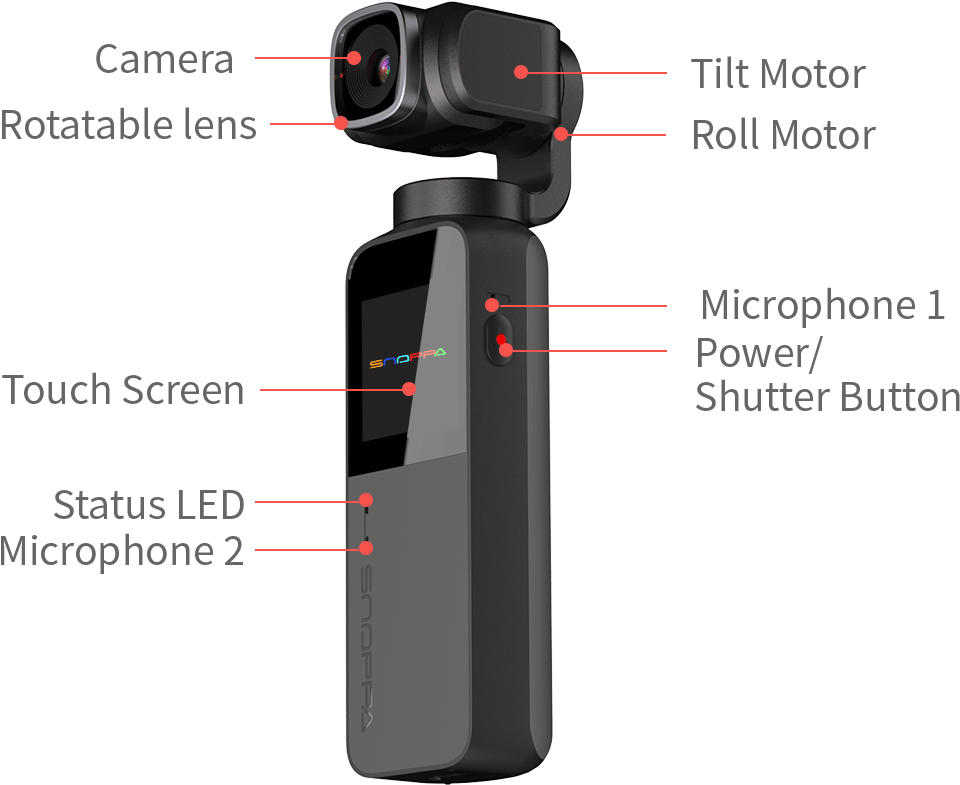
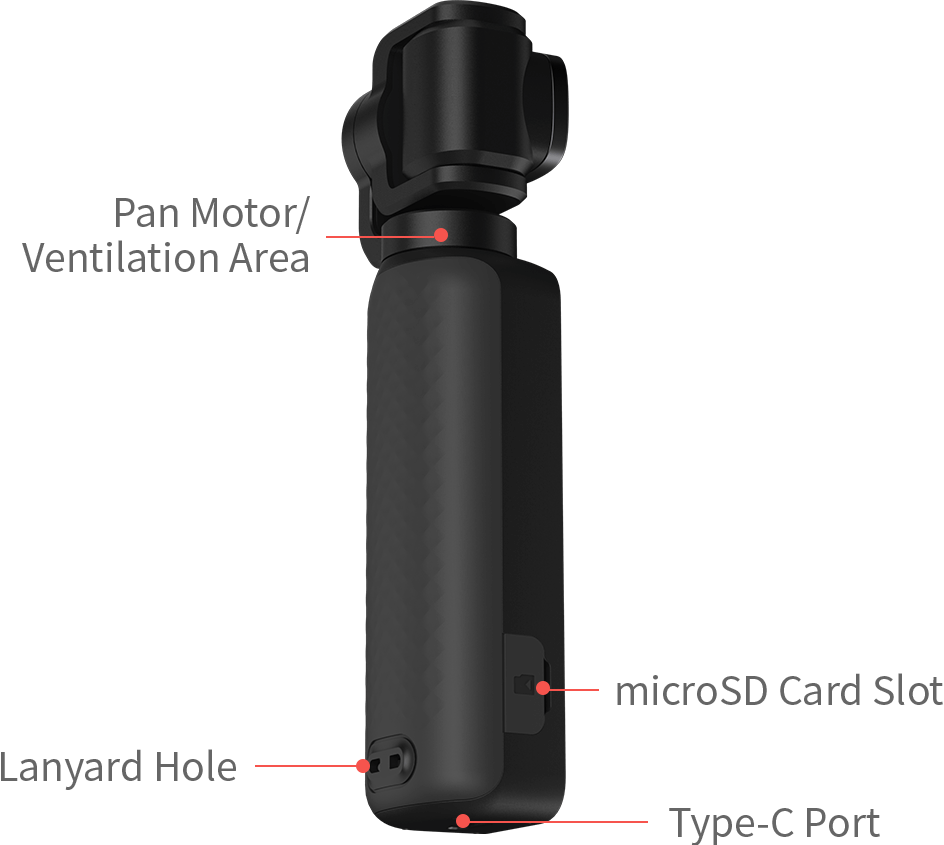
2. Product Maintenance
Storage
Follow the below instructions to put multi-functional case on the Vmate; pay attention to the camera orientation to avoid damage.
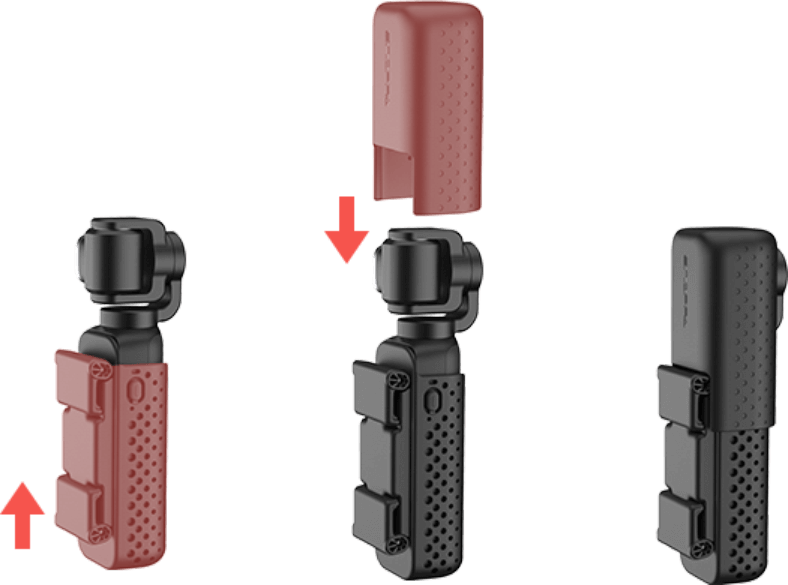
*
Vmate camera will rotate to a certain direction for 15~20s which is easier to put upper cover on.
The multi-functional case can be a phone holder while protecting Vmate, efficiently for one-handed operation.
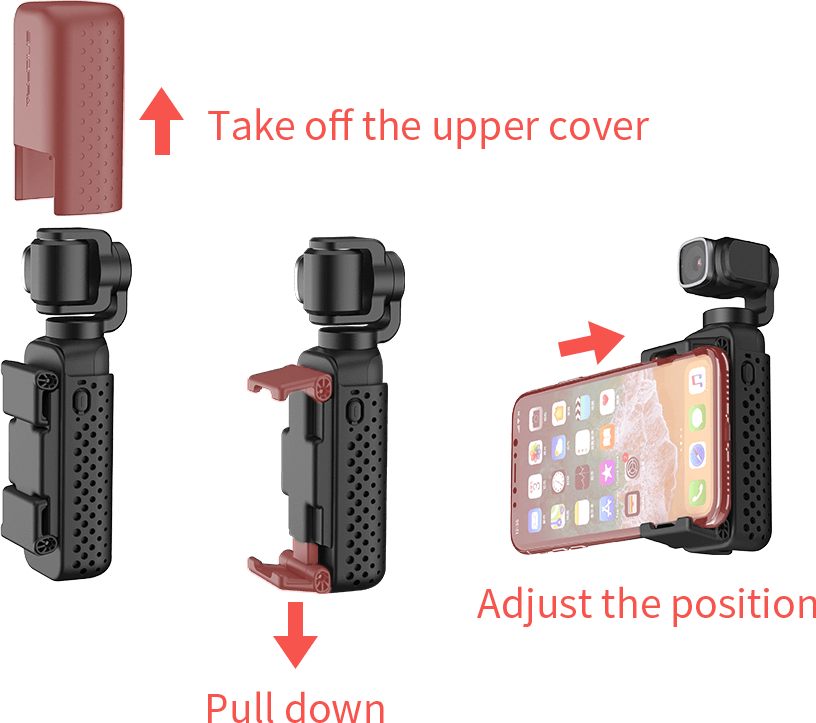
3. Power/Record Button
1.
Power On/Off
Power On: In the off state, press the Power/Record button for around 1 second.
Power Off: In the power-on state, press and hold Power/Record button for about 2 seconds.
*
If your device isn’t working or won’t turn off/on, as usual, you can force to restart it. Just press and hold the Power/Record button for 15 seconds or longer.
*
There will be movement of Vmate three axes (roll, pitch, and yaw) for self-test during booting up; Do not touch the device during the period to avoid affecting the equipment performance.
*
Self-discharge in batteries will happen during storage; please charge the device before turning it on if the product cannot boot up normally.
2.
Photo/video
Under the shooting interface, tap the power/recordshot button to take photos or videos
3.
Back to Camera View on the Touch Screen
On any pages on the touch screen can short press the power/shutter button go back to camera view page in an instant (exclude camera view page itself)
4. Insert the microSD card
Insert the microSD card (Self-purchase) into the microSD card slot as shown
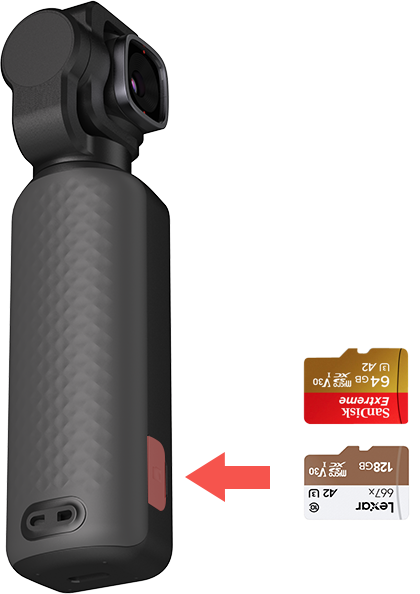
It is recommended to use a microSD card with or over a UHS-1 Speed Class 3 (U3), the max capacity is 512 GB.
Be sure to format the microSD card via the device at the first use before recording videos/pictures.
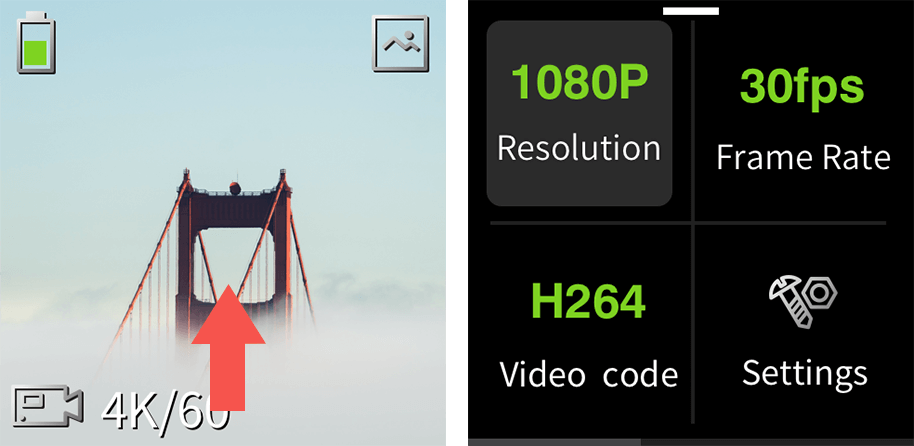
Swipe up on the touch screen to enter gimbal Settings page
Tap Settings
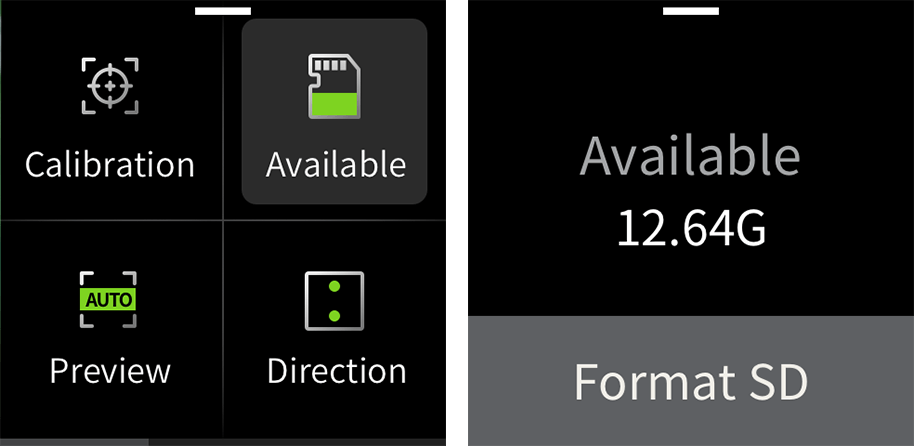
Tap Available
Tap Format SD
*
Due to the complexity of SD card parameters, below SD card brands and models are recommended:
1.SanDisk UHS-1 U3 - 64G and over
2.Lexar 667x and over
*
A microSD card is required to update firmware and shoot pictures/videos.
5. Charging
When the battery level is low, the red light is always on if turned on the device. Charge the device in time in case it running power out and shut down.
Using the Charger that Came with Your Device
1.
Use the USB cable that came with your Vmate to connect your Vmate and the adapter (User-supplied).
2.
Plug the adapter into a power socket.
Charging time: Approx. 100 mins (when using a USB adapter of 5V/2A).
Refer to the below for status LED instructions.
Low battery:
Solid red
Charing:
Blinks green
Full battery/Normal:
Solid green
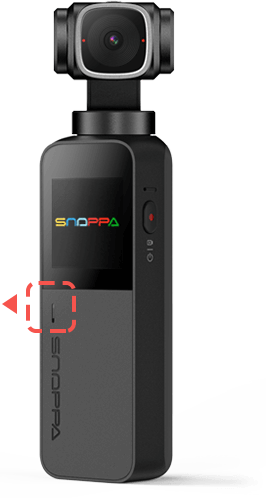
6. Rotatable lens
Hold the camera rotatable lens with hand and rotate the lens 90 degrees counterclockwise to switch to “landscape filming”.
Hold the camera rotatable lens with hand and rotate the lens 90 degrees clockwise to switch to “vertical filming”.
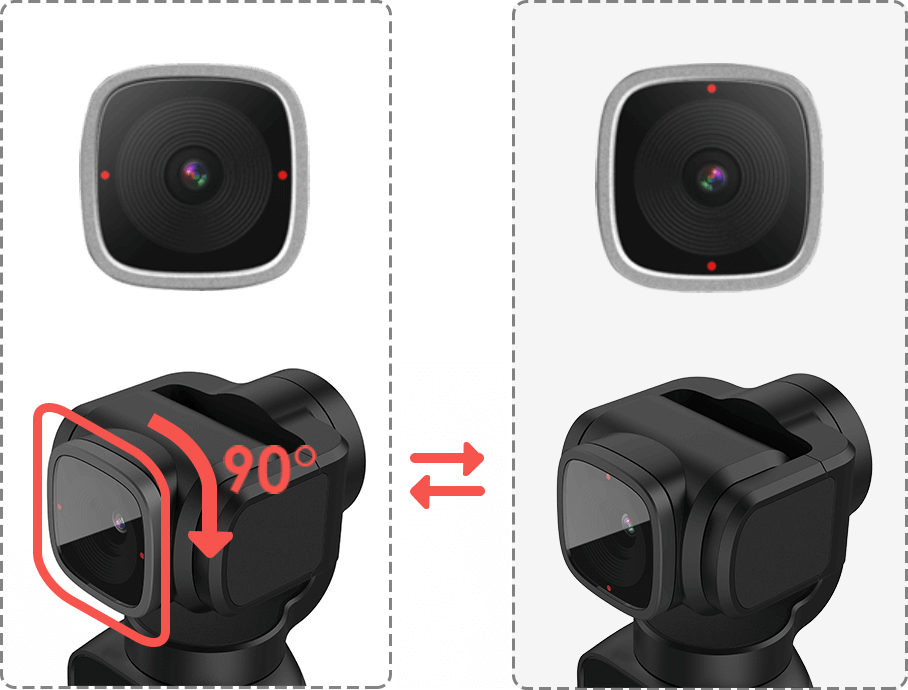
Landscape
Portrait
*
Set landscape/portrait mode through Vmate touch screen at the same time when rotated rotatable lens to landscape/vertical filming.
7. Operating the Touch Screen
The touch screen displays the camera view after turned on Vmate, as well as the shooting parameters, battery level and album etc.
Details as follows:
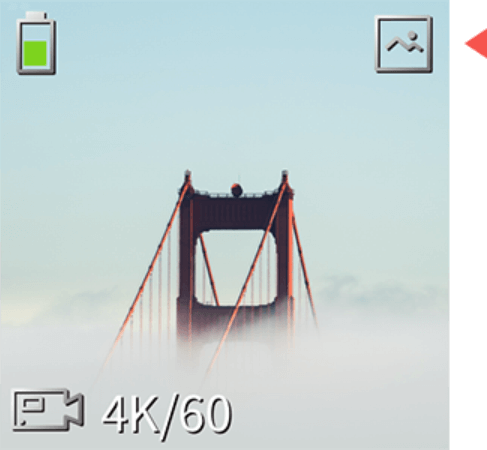
Media library, tap to view shot pictures/videos.
Show current shooting mode and parameters.
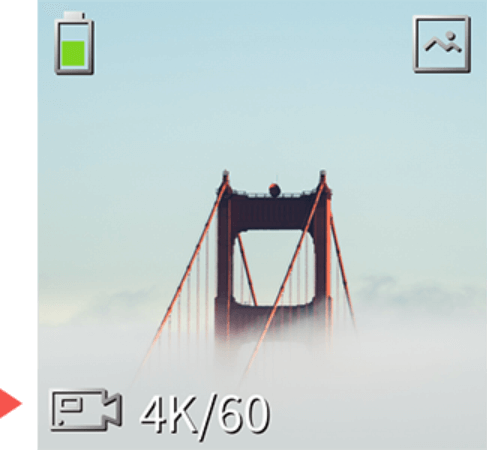
Touch screen camera view:
No-icon if with SD card and sufficient memory
8. Swipe Right
Swipe right on the touch screen to enter the shooting mode settings page and swipe up or down to select the desired shooting mode.
The displayed shooting mode will automatically be the current shooting mode, then tap the screen or swipe left to back camera view.
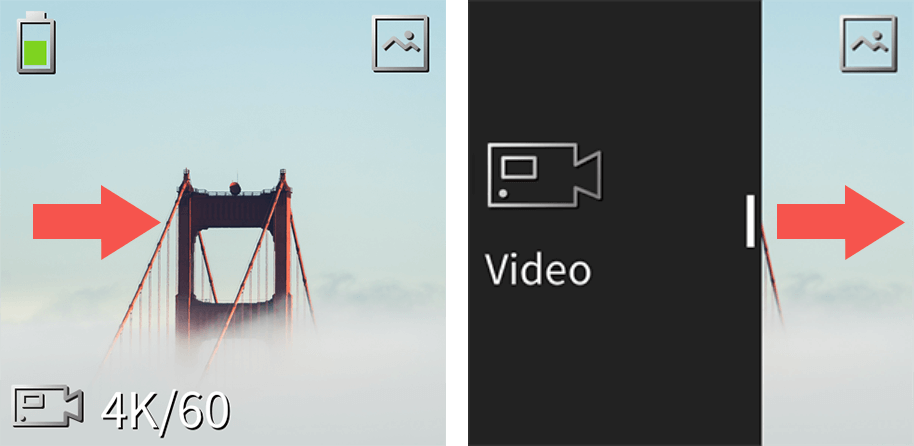
Swipe right to enter shooting mode settings page
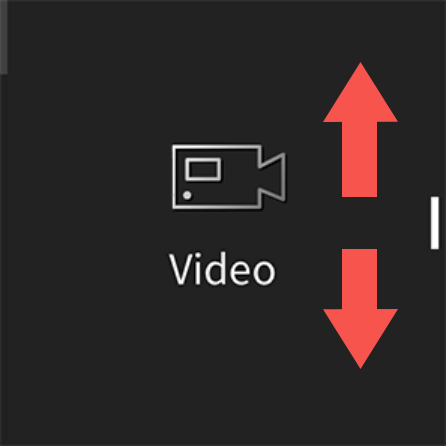
Swipe up or down to select desired shooting mode
*
Swipe up on the camera view page to set shooting parameters for current shooting mode.
Video
Supported to set the video resolution, frame rate, and video codec.
1080 24/25/30/50/60;
1080+(1080p downsampled 4K)
24/25/30/50/60;
4K 24/25/30/50/60
H.264; H.265
Photo
Supported to set photo format and ratio.
JPG; DNG
3:2;4:3;16:9
Panorama (not available in portrait mode)
Supported to set photo format and ratio.
90°/180°/270°/3×3
90°: four lateral images combine to one picture
180°: seven lateral images combine to one picture
270°: ten lateral images combine to one picture
3×3: three images above in every three layers combine to one picture
3:2;4:3;16:9
*
Must connect Vmate App for panorama shooting; the shot panorama picture will store in the phone's album automatically; please tap “Local” in the Vmate App album if you need to view it via Vmate App.
Timelapse
Supported to set shooting interval, duration, and resolution.
0.2s/0.5s/1s/2s/4s/8s/10s
10s/30s/1min/2mins/5mins
1080p;1080+;4k
Slow motion
X2/ X4/ X8
H.264; H.265
1080/1080+/4K
Night photography
Supported to set exposure time, picture format and ratio
auto; 1×; 2×; 3×; 4×; 5×; 6×; 7×
JPG; DNG
3:2;4:3;16:9
9. Swipe Up
Swipe up on the touch screen to set parameters of current shooting mode or enter the gimbal settings page.
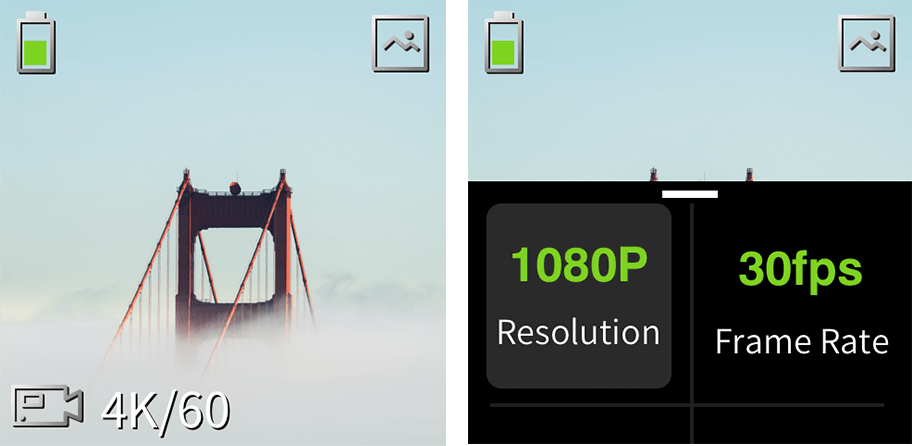
Swipe up to enter settings page
Tap settings icon to enter the gimbal settings page, swipe left or right to select a setting.
to enter the gimbal settings page, swipe left or right to select a setting.
10. Swipe Down
Swipe down on the touch screen to enter gimbal follow mode settings page, tap to select the desired follow mode, swipe left and right to view the all follow modes.
Swipe up on the follow mode settings page to back the camera view page after selecting the desired follow mode.
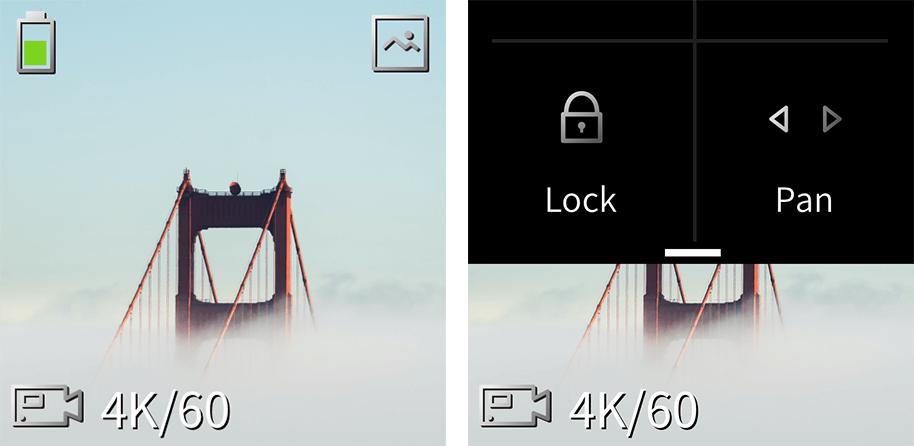
Swipe down to enter the follow mode settings page.

Swipe left and right to select the desired follow mode.
11. Controlling camera movement on the touch screen
Tap and hold the right of the touch screen to manipulate camera up and down movement;tap and hold the bottom of the touch screen to control the camera left and right movement.

Move the camera horizontally
Move the camera in the pitch directio
Re-center
Swipe from the right edge of the touch screen to the left to re-center the camera.
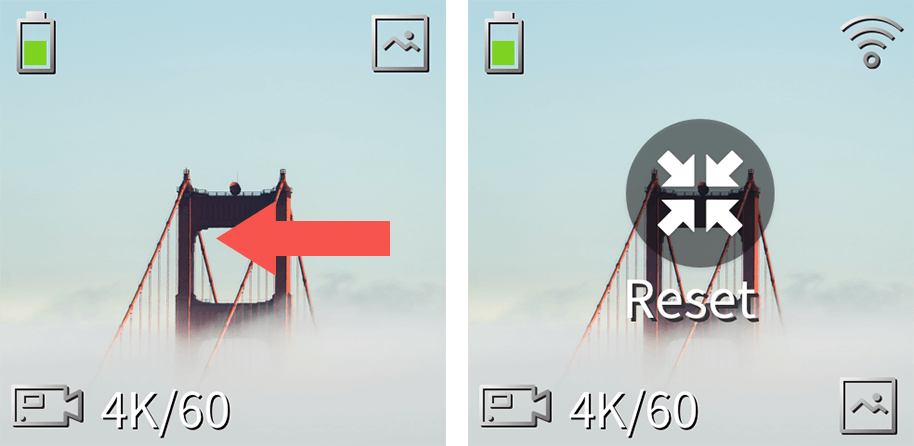
Swipe from right to left, re-centered
Flip
Swipe from the right of the edge of the touch screen to the screen middle and immediately slide to the right to switch the gimbal facing forward or backward.
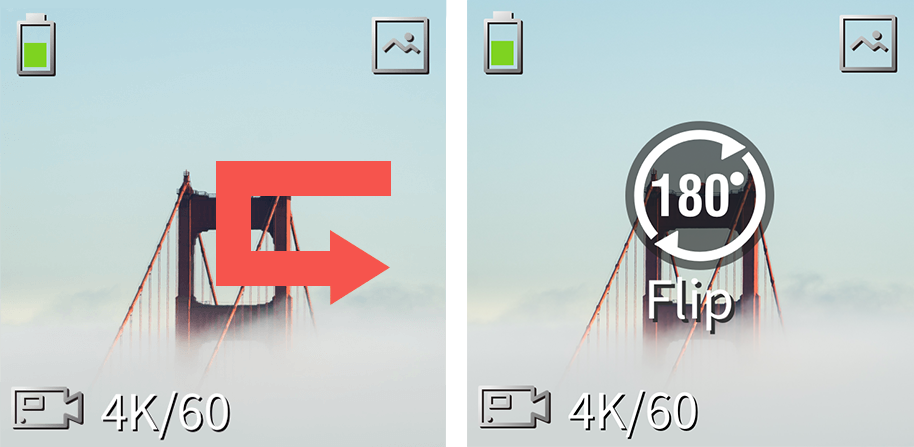
Swipe from right to left then to the right, flipped
12. Media library management
Tap media library icon on the top right corner of the touch screen to enter the media library, swipe left, and right to view shot pictures or videos.
Swipe up on the media library page, and tap  to delete the current picture or video, or swipe down continuing view the picture/video.
to delete the current picture or video, or swipe down continuing view the picture/video.

Tap the icon on the screen top right corner
Swipe up on that page
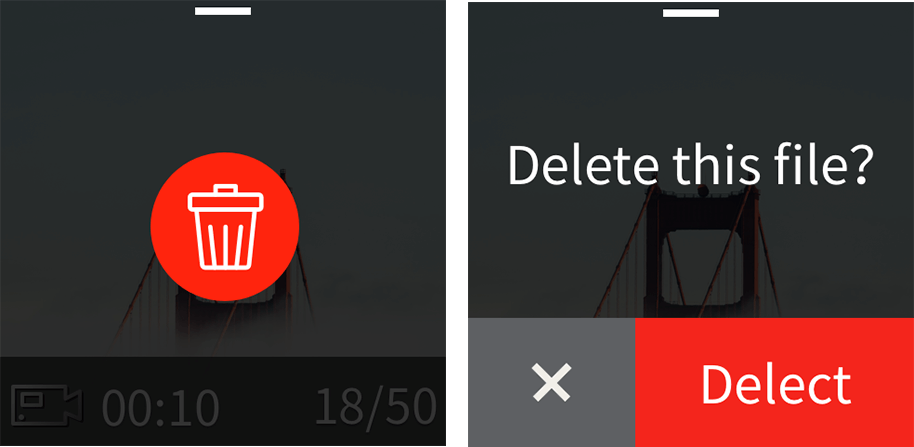
Tap delete icon
Tap delete button to delete picture/video
13. Downloading the Vmate App
Select a button below to download Vmate App.
For Android phones, please tap Google Play or Android App button to download the Vmate. For IOS phones, please tap App Store Button to download Vmate App.
(The name of Vmate App on IOS is "Vmate" and on Android is "Snoppa Play")
*
The IOS version of Snoppa Vmate is compatible with IOS V11.0 and later; the Android version of Snoppa Vmate is compatible with Android V8.0 and later.
14. App Connection
Launch Vmate App after confirming that Bluetooth and Wi-fi settings of the phone are turned on, then tap “Connect the device” to enter the device searching page, select device name currently in use (device name start with vmate) and tap “Join” to connect with the device.
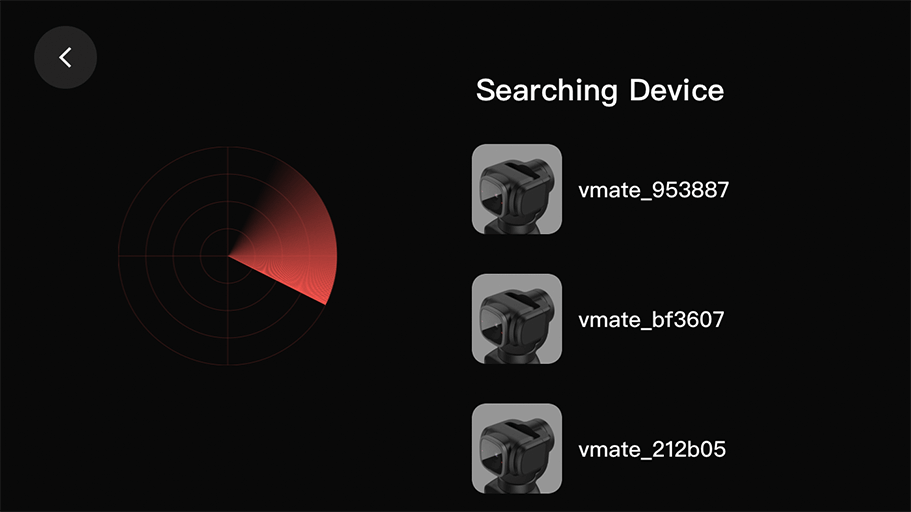
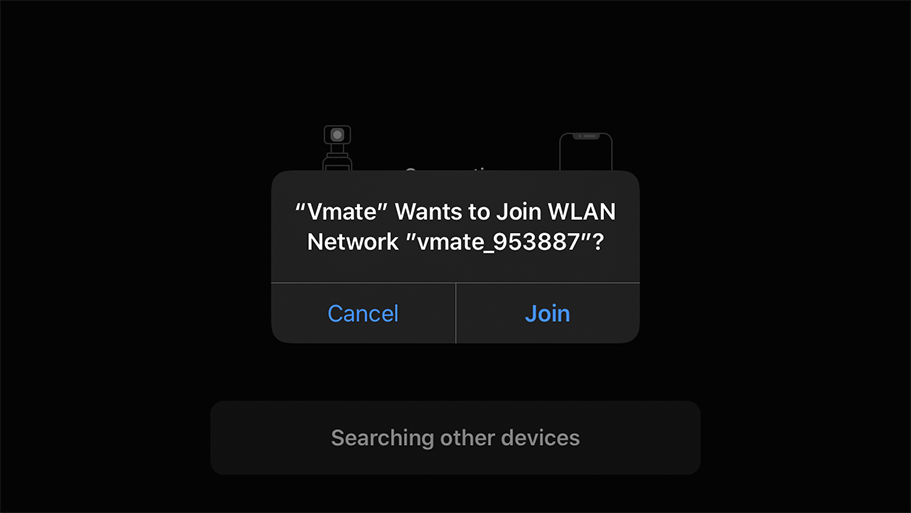
Please follow the instruction (P1) to tap the "confirm" icon  (P2) on the touch screen of the device to complete the connection after successful authorization.
(P2) on the touch screen of the device to complete the connection after successful authorization.
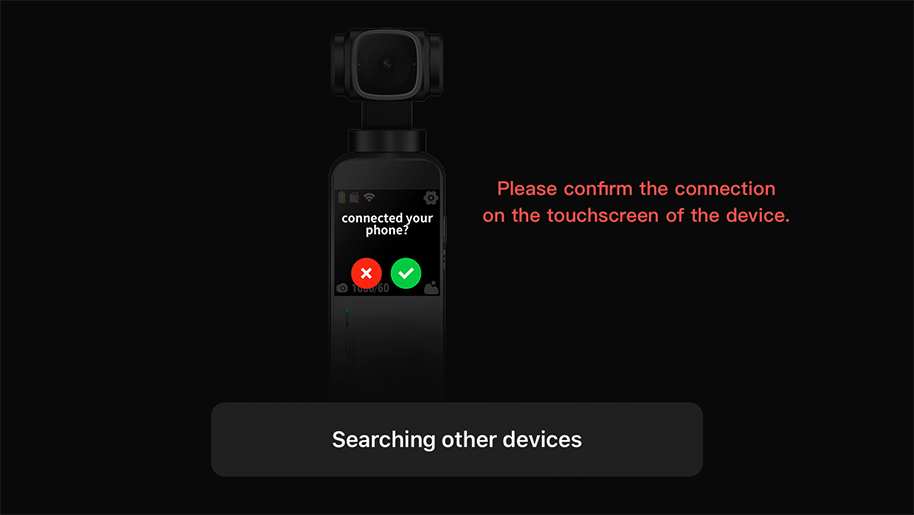
P1
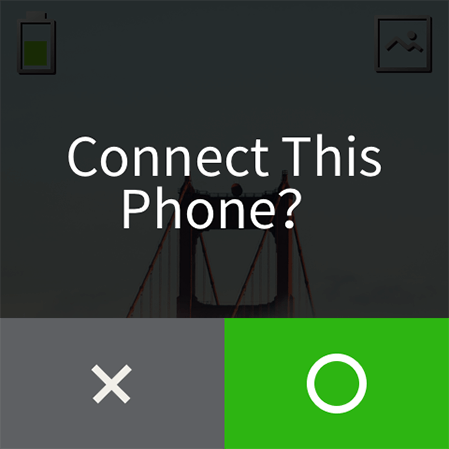
P2
Reminder: The touch screen of the device will automatically dim to save power; please operate shooting directly via the Vmate app; If you want the touchscreen back to work, tap the screen to bright and swipe up to cancel the dim mode.
15. App Interface Introductio
Home Page
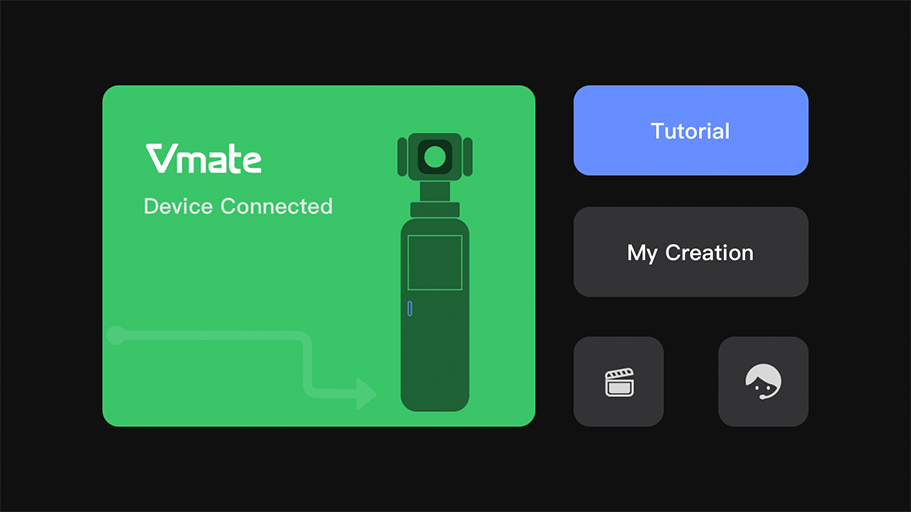
Camera View
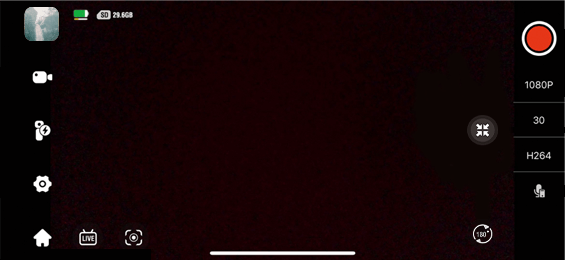
16. Updating Firmware
Vmate supports updating firmware online or via microSD card, it is recommended to upgrade online.
Upgrade online
When Vmate app-connected, an on-screen alert will be received if new firmware is available. Follow the on-screen instructions to update the firmware.
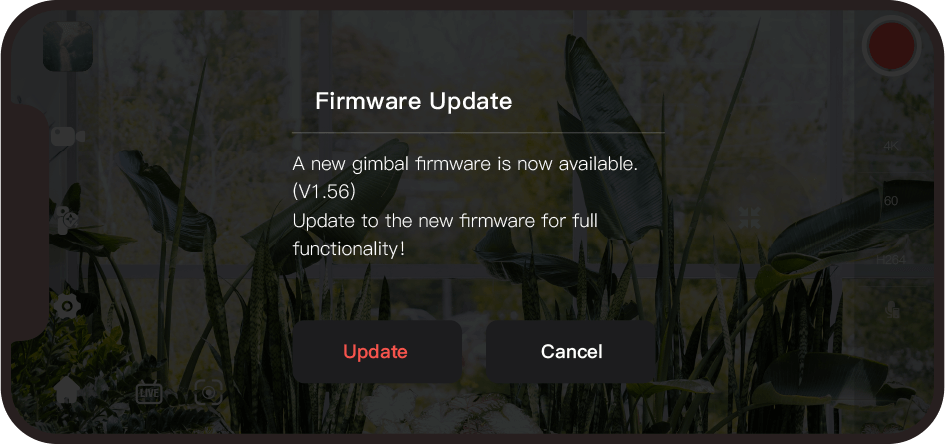
Or tap  on App camera view page to enter gimbal settings page, slide down to view the current firmware version; tap
on App camera view page to enter gimbal settings page, slide down to view the current firmware version; tap  to upgrade the firmware if there is a new firmware version available.
to upgrade the firmware if there is a new firmware version available.
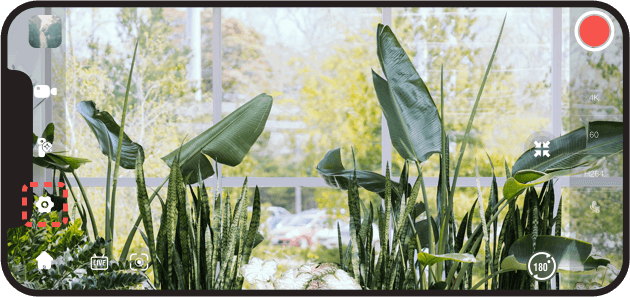
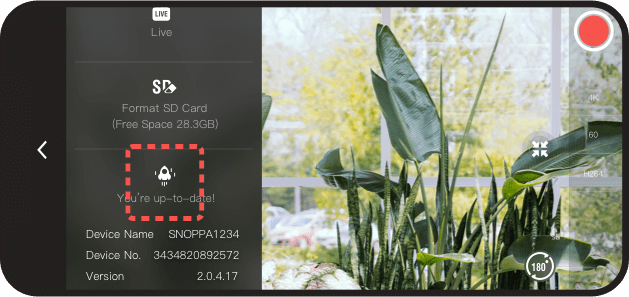
Upgrade via microSD card
1.Insert SD card into Vmate SD card slot, enter settings page on the touch screen to format SD card.
2.Visit https://www.snoppa.com/updatefailed.html and follow the instructions to download the firmware pack and unzip it, then move the decompressed package to the SD card. (do not rename the folder)
3.Reinsert SD card with firmware pack into Vmate SD card slot when Vmate is in shutdown status, long-press the Power/Shutter button till the green light blink. (Flashing green light indicates that the firmware is being upgraded, please be patient)
4.Vmate will automatically restart when the update complete.

*
1. A microSD card is required to update firmware;
2. Make sure Vmate battery level is enough before updating firmware;
3. Vmate will automatically restart when the update complete.
17. Maintenance Notes
Vmate gimbal camera is a hign-precise control device. Please do not drop it or have it hit by external force. And please ensure that the gimbal doesn’t be blocked by outside forces when it is moving. Otherwise, the machine might be damaged and be led to abnormal operations.
Make sure there is nothing obstructing the gimbal when Vmate is powered on.
Vmate is not water resistant. DO NOT use any liquid cleansers. Only use a soft dry cloth to clean Vmate.
Keep Vmate aways from sand and dust to safeguard the sensors in the motors.
The surface of Vmate camera and touchscreen are glasses, be careful to avoid from cracking breaking.
To ensure the battery life of Vmate, please store Vmate in a cool and dry place after fully charged if the device will not be used for a long time.
18. Specifications
General
Name
Vmate
Model
S191
Dimensions
122 x37.6 x32.3 mm
Weight
125g(Vmate only)
Case Weight
46g
Gimbal
Controllable Range
Pan: -270˚ ~ +90˚
Tilt: -98˚ ~ 50
Roll: ±45˚
Max Controllable Speed
120°/s
Angular Vibration Range
±0.005°
Operating Temperature
0°C~40°C
Battery
Type
LiPo
Capacity
2100mAh
Voltage
3.7V
Operating Temperature
0°C~40℃
Operating Time
210 mins
(1080p/30fps, video shooting by device only)
150 mins
(4k/30fps, video shooting by device only)
100 mins
(4k/30fps, video shotting by app-connected)
Charging Time
100 mins
*When using a USB adapter of 10W (5V/2A)
Camera
Sensor
1/2.3” CMOS
Effective pixels: 12M
Lens
FOV:81°,F2.0
Equivalent focul lengt:26mm
ISO
Photo:ISO 100-3200
Video:ISO 100-3200
Max Image Size
4000x3000
Photo formats
JPEG,DNG
Video Resolution
4K Ultra HD: 3840x2160 @24/25/30/50/60fps
FHD: 1920x1080 @24/25/30/48/50/60/120/192 fps
Video Recording Modes
Video/Slow motion/Timelapse/Hyper timelapse/Trace Timelapse
Max Video Birate
200 Mbps(H264);100 Mbps(H265)
Supported SD Cards Type
FAT32
Video Format
MP4
Supported SD Cards Type
Micro SD(U3)Max:512GB
Audio Output
48 KHz; AAC
Wireless
Bluetooth
Bluetooth 4.1
Wi-Fi
Wi-Fi 802.11ac(5G)
USB Port Type
USB3.1 Gen1 Type-C
Video Codec
MPEG-4 VC/H.264/H265
Compatible Phones for Case
Thickness
≤10mm
Width
61-84 mm

Click

in the top right corner
Select

Open in Browser












 to learn how to obtain RTMP URL and stream code.
to learn how to obtain RTMP URL and stream code.


